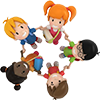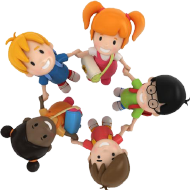
BEING OUT IS IN!
|
||

The outdoors provides so many opportunities for child development. As children explore playgrounds and parks, sensory experiences are everywhere. Children have the chance to watch others play and socialize, and are encouraged to challenge themselves. Coordination, motor planning, strengthening, balance and visual gross motor skills are just a few things that a trip to the park can facilitate. Trying different parks every week also encourage your child to adapt and try newly learned skills in a slightly different arena. What a great confidence builder for your child! Take advantage of the sunny days and let your child’s confidence level soar! July is Park and Recreation Month This July we’re celebrating 30 years of Park and Recreation Month and the enduring importance of parks and recreation for the world. From the start, parks were created to serve the people to give them place to appreciate nature, exercise, socialize and have fun. This mission lives on and will continue to intensify into the future, This July, let’s celebrate the past, present and future. Technology HubTap to Talk
Awesome game like app to teach communication. Tap the picture and the Tap to Talk speaks. With over 2,000 pictures and the ability to add your own photos and sounds, this program allows you to create a very individualized album for your child. Plus it is amazingly FREE. Reading App- iStoryTime Kids Books Free Books -23,469 classics to go. – Spreadsong, Inc Quote of the Month
Activity of the MonthNature Scavenger Hunt Summer is the perfect time to go on a Nature Scavenger Hunt with the kids! Take a picture of the list below and go for it! Nature Scavenger Hunt
|
Does your baby have a flat head?
Today, many more babies have flat spots on their heads, a huge increase from 20 years ago. In fact, it is now common to see babies out in public wearing orthotic helmets and to hear stories about their courses of physical or occupational therapy. In the 1970’s, studies showed that 1 in 300 infants were diagnosed with plagiocephaly (flat head); current numbers are as high as 1 in 2 with up to 1 in 6 receiving treatment. Positional plagiocephaly is a deformation of the skull bones in an oblique shape due to prolonged pressure on one part of the skull. Infants’ skull bones are not yet sutured together. Skull shape is dependent upon the forces placed upon the bones, internally from brain growth and muscle pulls, and externally from surfaces and gravity. Plagiocephaly is categorized as mild, moderate, or severe depending on the measured difference between the skull’s left and right diagonals. Torticollis, is a shortening of the sternocleidomastoid (SCM) muscle. It presents as a head tilt to one side (ear to shoulder) and a turn to the opposite side (chin toward opposite shoulder). Parents often notice that baby has a preference for turning and holding her head either left or right. Positional plagiocephaly has increased substantially since 1992, coinciding with the American Academy of Pediatrics’ recommendation that babies be placed on their backs to sleep to reduce the risk of SIDS, as well as the rise of our container culture.  Still important for babies to sleep on their backs Despite this unintended consequence of flat heads from safe sleeping positions on their backs, it is important for babies to sleep on their backs to reduce the risk of SIDS. In addition, babies are too often placed in all the accessories for on-the-go babies; infant seats, swings, walkers, and jumpers, rather than carrying the baby or simply placing the baby on the floor, where real development occurs. Plagiocephaly and torticollis often go hand in hand because young infants have poor head control as they learn how to move against gravity. If a baby has a flat spot on one side, she will more likely hold her head with that spot against the ground, crib mattress, car seat, or infant carrier. As that flat spot rests against the surface, it becomes larger and broader over time, which also affects the length of the muscles attached to that bone. As time goes by, it is a vicious cycle that causes each diagnosis to become more severe. These diagnoses may be present at birth, but can often be remedied without the need for physical or orthotic therapies. It merely requires careful observation and tracking over time as well as consistent implementation of a few simple interventions. What to look for:
  What to do:
|
|
|
If you have questions about your child’s development, call us at (708) 226-9200 or |
||
|
14711 Ravinia Ave. Orland Park, Il 60462 |
||





